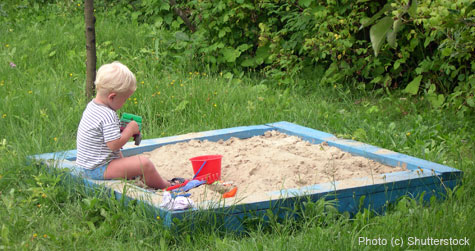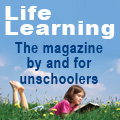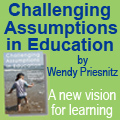|

Just Playing
By Susan Wight
Many adults fervently believe that there can be no “educational value” in something that children choose to do...that they might “just play.” Adults are very sceptical that play, which looks to them like merely a pleasant pastime, can really be the most stimulating thing children do.
Development experts are actually alarmed by the lack of time and interest devoted to unstructured child’s play in modern culture. “Everything about children’s lives these days seems to be so serious, and play looks like it’s not valuable enough,” says Jane Healy, psychologist, educator and author of Endangered Minds: Why Our Children Don’t Think and What We Can Do About It.
Many children, locked into a relentless round of school, homework, and extra-curricular activities, are just not given enough time to play. Studies by the University of Michigan have found that since the late 1970s, children have lost twelve hours per week in free time, including a twenty-five percent drop in play and a fifty percent drop in unstructured outdoor activities. Meanwhile time in structured sports has doubled. In addition, the amount of homework has increased dramatically.
“I just don’t think parents – or even policy makers – understand that children’s spontaneous, self-generated play has tremendous potential to actually enhance brain development and increase kids’ intelligence and academic ability,” says Jane Healy. Denying children the opportunity for plenty of self-directed play, she says, short-circuits a lot of their development. “That’s because play is the way that children work out their emotional issues, their fears, their anxieties. It’s the way they develop a self, a way they develop a sense that they are important people who have ideas to share and who can get along with other people.”
Play and Learning
Play is accepted in babies and small children as a valid pastime. As Penelope Leach points out in her book Baby and Child: “For a small child there is no division between playing and learning; between the things that he or she does “just for fun” and things that are “educational”. The child learns while living and any part of living that is enjoyable is also play.”
But when children are aged three or four, our society encourages parents to think that “guided play” is superior to free, unstructured play. The devaluing of children’s own natural and inquisitive play begins here. For an increasing number of children, it is curtailed even earlier in child- care centres where their play is limited by group sizes, time constraints, staff numbers, and the concept that some structure is desirable.
Kindergarten teachers are reporting that some children seem to have forgotten how to play. Released from the building for outside time, they simply run backwards and forwards in the yard. Encouraged by staff to begin a game in the sandpit, they abandon it as soon as the adults leave the area. Perhaps the point is that they have spent so much time in structured activities and inside that they have a need to run until they have had enough running. They would then naturally move on to other forms of play.
Jan Faull, a child development and behaviour specialist, says that pre-schoolers who spend more time in dramatic play are moreadvanced not only in general intellectual development but also in their ability to concentrate for long periods of time.
Once a child has passed five or six years, the common perception of play moves swiftly and irrevocably from an efficient way of learning to something physically beneficial but not considered a method of learning.
Plato, Aristotle, Locke, Rousseau, and Dewey all agreed that play was important in the education of children and Piaget’s theory of play was closely bound to his account of the growth of intelligence. Modern teaching practice therefore seeks to use play as a teaching tool, but adults predetermine what is to be learnt and design the game in order that the learning might be swallowed much as a sugar coated pill.
Summerhill school founder and author A.S. Neill heartily disapproved of such tactics. “Even the Montessori system, well-known as a system of directed play, is an artificial way of making the child learn by doing,” he said. He believed that children should be permitted to play as much as they wished. “The function of the child is to live his own life – not the life that his anxious parents think he should live, nor a life according to the purpose of the educator who thinks he knows what is best. All this interference and guidance on the part of adults only produces a generation of robots.”
Summerhill critics feared that children permitted to choose between play and lessons would be lazy but Neill countered that he had never seen a lazy child. “What is called laziness is child cannot be idle; he has to be doing something all day long.”
Adults fear their children will be failures in life if allowed to play instead of doing lessons. They are anxious for learning to be demonstrated early in order that their children will gain and keep “an edge” over other children. Play actually helps children both at the time and in later life. Neill was able to provide countless examples of the later success in life of ex-Summerhill children. He believed that much of their success and confidence in life was attributable to the fact that “As young adults they are able to face the realities of life without any unconscious longing for the play of childhood.” One former pupil of Summerhill who went on to university said, “The students make a hell of a row in classes, and it gets rather tiresome, for we at Summerhill lived out that stage when we were ten.”
Education reformer and author John Holt pointed out that the essential requirement to allow children to learn in their own way is trust. Holt trusted children and respected their play. He believed: “A child has no stronger desire than to make sense of the world, to move freely in it, to do the things that he sees bigger people doing.” His early observations as a teacher showed him that allowing children to play with equipment enabled them to master it without being taught and that teaching was actually more likely to lower a child's confidence and mastery of the same equipment.
Holt quoted David Hawkins, Professor of Philosophy, who also found that children benefited from time devoted to free and unguided exploratory work with scientific equipment. Hawkins’ students rewarded him with a higher level of involvement and a much greater diversity of experiments. He found that most of the questions which might have been planned for the equipment came up naturally. Discoveries were made, noted, lost, and made again. Holt asserted, “Children are by nature smart, energetic, curious, eager to learn and good at learning” and that, therefore, “We can trust children to find out about the world, and that when trusted, they do find out.” He noticed also that “with great subtlety and skill, as they play, they adjust to each other’s needs and feelings, respond from one second to the next to what the other says and does.”
Watching children play teaches us that they really are constantly learning. Children are in a very real sense like scientists discovering natural laws. As babies and as toddlers, children’s experiments gradually teach them the rules which govern the behavior of objects in the world. When they drop something, it falls down. Always down, never up. Long before they hear the word “gravity,” they discover its effects for themselves and come to expect that a dropped object will subsequently be on the floor.
Play is learning and practising what they have learned. It is exploring and discovering. It stimulates their minds and their senses. It develops their thinking, their confidence, and their independence. They construct, they build, they draw, they dig, and they exercise their bodies. The list could go on and on. In everything they do, their skill level increases naturally. They learn to count toy cars, add blocks, and divide dolls by the number of players. They learn to sort and classify, to identify, and later read labels on their toys and games.
The problem solving in play forms habits of autonomous and co-operative learning. They spend hours in imaginative play constructing make-believe worlds – sometimes alone, sometimes as a group. They play at shopping, camping, banking, and visiting friends. Sharing, turn-taking, cooperation, team work, and conversing increase as they work out the intricacies of the game. New information, vocabulary, knowledge, and experiences are incorporated into their games constantly.
Emotional and Social Benefits
Play also has emotional and social benefits. Re-enacting emotions helps children to understand their feelings and, according to author and parenting columnist Jan Faull, after engaging in pretend play involving emotions, children show an enhanced ability to empathize with the feelings of others. Children who spend lots of time engaged in imaginative play score highly on tests of imagination and creativity. Play is so necessary and valuable that child therapists encourage children to play in order to work through deep-seated problems.
Despite what the advertising industry would have us believe, a plethora of toys is not necessary for rich, imaginative, beneficial play. Children can use anything to hand for their games and in some ways, the more expensive a toy is the more it limits the child’s play. Joan Almon, co-ordinator for the U.S. Alliance for Childhood, tells the story of two girls who were comparing their dolls. One girl had a talking doll and boasted, “My doll can say five hundred words!” The other girl was holding an old- fashioned cloth doll and countered, “My doll can say anything I want her to say.” Almon fears, “We are creating a culture where we are giving children all the content that we think they need for their imagination, without realizing that in the process we are stifling their imagination.”
As children grow older, their play evolves. They play long, complex, imaginative games that give them wonderful material for story writing if they are so inclined. By contrast, school children whose play time is limited are often asked to write stories and don’t have that rich imaginative experience to draw on. The older children become, the more anxious adults become about allowing them to continue to spend a great deal of their time playing. Holt said, “One might feel …that play is fine for little children, and even the best thing for them, but that after a while they must outgrow it and learn more ‘serious’ or ‘adult’ ways of learning. This would be a great mistake. The fact is that in their play children are very often doing things very much like what adults do in their work. Like the economist, the traffic engineer, the social planner, or the computer expert, children at play often make models of life or certain parts of life, models they hope are a fair, if simpler, representation of the world, so that by working these models they may attain some idea of how the world works or might work or what they might do in it.”
For teenagers, time spent playing, apart from in organized sports, is seen as wasteful and frivolous. However, although play changes and the time devoted to it decreases, it remains important. A teenager might enjoy playing with model aircraft, testing and watching and designing by trial and error the best flying machine she can. Some aircraft industry may benefit from her play in the future but only if adults can give her the space, time, and respect to work through what she needs to, solving problems as she goes, instead of dismissing what she is doing as unimportant.
Thomas Edison’s mom knew well enough that he liked messing around with lots of gadgets. She simply moved his equipment down to the basement so that he could continue uninterrupted.
The next time you begin to worry that your children are “just playing” instead of learning, remember that play is exploration, discovery, research, and experiment. Your children are testing theories, revising ideas – and always learning.
Susan Wight is the coordinator of the Home Education Network in Australia, editor of Otherways Magazine and co-author of the book Tales Out of School. She has also contributed articles to Life Learning Magazine. Her three sons spent most of their childhood in free play. Whole weeks were spent with them playing episodes of ongoing games they took turns at leading. At some point they began writing their games down and making them into books. They are all now making their way successfully in the world and their years of play have stood them in good stead.
Copyright © Life Media
Privacy Policy
 



|

